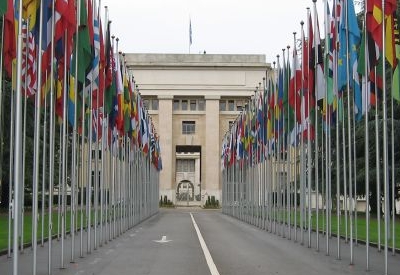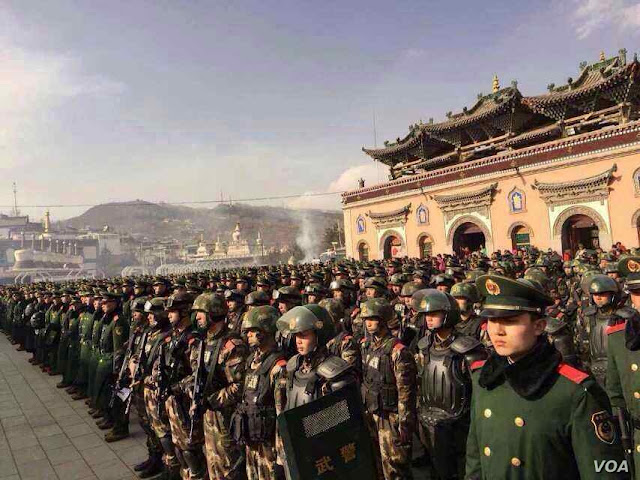of Hobbes, Tibet, and Palestine
 |
In Yarmouk, Palestinian Refugees Paint Amid the Ruins |
authorize all the actions of the sovereign
“that hath their lives and liberty in his
power.”1 The defeated groups surrender
should be unconditional and it should be
signified as a relationship between the
master and the servant. This “dominion” is
then acquired to the victor when the
vanquished , to avoid the present stroke of
death, covenant, with in express words
or by other significant signs of the will, that
so long as his life and the liberty of his
body is allowed him , the victor shall have,
the use thereof at his pleasure.”2
Jabareen is referring to absolute surrender
by the Palestinians to Israelis upon
formation of the first Knesset and
territoriality that was imposed on them
through Israeli Parliamentary procedure,
that exists to this day. There is the obvious
comparison to Tibetans and the
occupation by Chinese authorities that
remarkably, covers an almost identical
period of time and offers no sign of
resolution in either case. Moreover, one
can say with probable cause, the existence
of an Islamic rebirth in the 20th century
that had much to do with the subjugation
of Islam to the new colonial powers
beginning in the 18th century.
If Tibetans, prima facie, were to exhibit the
same tactics to avenge their occupiers
mistreatment, Tibetans prima facie can
expect little to no support from the
international community, and may find
themselves constantly ensconced in
periods of renewal and rebuilding from the
onslaught of Chinese munitions.
Therefore, to draw a similar comparison to
our Palestinian friends, is frankly, not very
invigorating because, given the
overcrowding and poor living conditions of
Palestinians, they (Palestinians) still control
some of their territory through their
elected government. Tibetans cannot claim
this right nor the right to freedom of
speech or expression that we sometimes
take for granted in the developed world.
Similar tacts by the international
community and the United Nations in a
post WWII universe; one stricture saw the
formation of an Israeli state; the other, the
absence of any meaningful dialogue with
Peking regarding conditions inside Tibet.
Israel’s management of the situation with
Palestine echoes Hobbesian ideology in
that obeisance to the state is based on
“surrender and humiliation.”
The international community lay witness to the
The international community lay witness to the
carnage on Palestinians by Israel, and in an
indirect manner, those nation-states that
support Israeli Zionist policy. Further, it is
apparent for all to see the backlash against
Zionism that has been ruinous to Israeli
security beginning with the First Intifada
from 1987-1993; the Second Intifada from
2000-2005, and a Third Intifada, which
occurred in 2014 around Jerusalem. In
addition, the “Arab Spring” that began in
Tunisia on December 18, 2010 can be
considered a regional uprising and not a
case of racial turmoil, that exists between
Israel and Palestinian Arabs.Similarly,
Tibetans are being marginalized by their
Asian occupiers, despite a lengthy
historical – geographical linkage.
Given the nature of Apartheid in Israel and
the Occupied Territories, the similarity
between Tibetans and China and the
former remain mired in illegitimate
support from the international community
and those agencies that support those
nation-states. It doesn’t take a wry
economist to acknowledge the financial
windfall of promoting trade with Beijing.
Not so for Israel, that is surrounded by
neighbours who would be quite happy to
see it disappear from the Near-East. The
crux is that the Palestine “state” has been
granted reasonable recognition to file
clams against the state of Israel through
the ICC (International Criminal Court) for
war-crimes; uprisings have seen a
disproportionate number of casualties that
Palestine has borne the cost of throughout
both periods of unrest and peace.
Tibetans, by comparison, and through
mostly non-violent measures, resort to
self-immolation to express dissent against
their Chinese occupiers, and are not of a
maudlin persona. The question is: why
not? First, Palestinians have an elected
government, that, while not given
widespread credibility, does provide
elections and support, if only token.
Tibetans, by contrast, have a government –
in – exile located in Dharmsala, India that
provides a voice to the international
community through its spiritual leader, The
Dalai Lama and Political Leader or
“Sikyong,” Lobsang Sangay.
In 2008, during the Summer Olympics, Tibetans
In 2008, during the Summer Olympics, Tibetans
found a vehicle to express their disdain for
treatment by Chinese officials through the
mass media that was foisted upon them by the central
government .
government .
There was a good deal of unrest that
resulted in vandalism and casualties to
both sides; casualty figures that were comparable
to conflicts between Palestinian and Israeli for this period.
to conflicts between Palestinian and Israeli for this period.
China’s response: shut down
communication inside Tibet and take a
hard-line against the Buddhist community,
which continues into 2015 and remains in 2019 with token assurances
from the central government regarding freedoms for journalists. Barring a
from the central government regarding freedoms for journalists. Barring a
complete economic melt-down by China,
the status quo seems most likely for
Tibetans; the international community
recognizes Tibet as part of China. In order
to create a fair opportunity for Tibet, a
strong presence by the United Nations (an
expanded Security Council) combined with
recognition by the ICC of the Tibetan
Government in Exile, may provide vigour to
Tibet’s hope for democratic reform. For
now, Palestine, has a comparative
advantage, yet, the “war of everyman
against everyman” persists in Tibet and the
Near-East.
http://www.palestinechronicle.com/in-yarmouk-palestinian-refugees-paint-amid-the-ruins-video/
article linked to photo
Works Cited
http://www.palestinechronicle.com/in-yarmouk-palestinian-refugees-paint-amid-the-ruins-video/
article linked to photo
Works Cited
1 Hobbes, Leviathan. 122
2Jabareen, Hassan. “Palestinians and
Hobbesian Citizenship.” Multiculturalism
and Minority Rights in the Arab World.
Kymlicka Will and Eva Pfostl. Oxford
University Press. 2014. 192.




